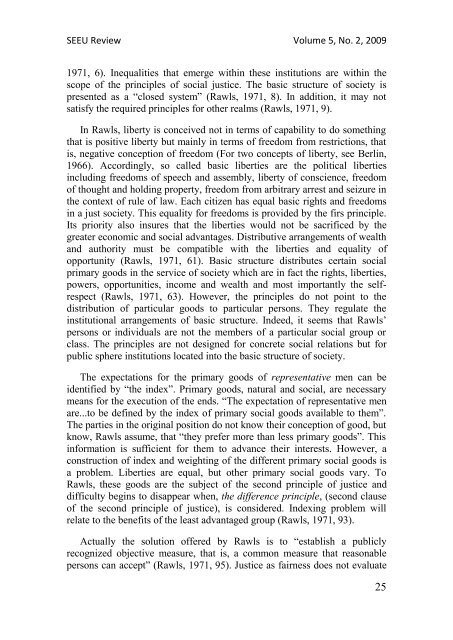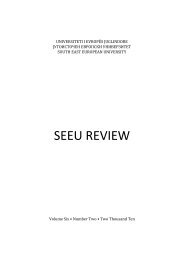SEEU Review vol. 5 Nr. 2 (pdf) - South East European University
SEEU Review vol. 5 Nr. 2 (pdf) - South East European University
SEEU Review vol. 5 Nr. 2 (pdf) - South East European University
Create successful ePaper yourself
Turn your PDF publications into a flip-book with our unique Google optimized e-Paper software.
<strong>SEEU</strong> <strong>Review</strong> Volume 5, No. 2, 2009<br />
1971, 6). Inequalities that emerge within these institutions are within the<br />
scope of the principles of social justice. The basic structure of society is<br />
presented as a “closed system” (Rawls, 1971, 8). In addition, it may not<br />
satisfy the required principles for other realms (Rawls, 1971, 9).<br />
In Rawls, liberty is conceived not in terms of capability to do something<br />
that is positive liberty but mainly in terms of freedom from restrictions, that<br />
is, negative conception of freedom (For two concepts of liberty, see Berlin,<br />
1966). Accordingly, so called basic liberties are the political liberties<br />
including freedoms of speech and assembly, liberty of conscience, freedom<br />
of thought and holding property, freedom from arbitrary arrest and seizure in<br />
the context of rule of law. Each citizen has equal basic rights and freedoms<br />
in a just society. This equality for freedoms is provided by the firs principle.<br />
Its priority also insures that the liberties would not be sacrificed by the<br />
greater economic and social advantages. Distributive arrangements of wealth<br />
and authority must be compatible with the liberties and equality of<br />
opportunity (Rawls, 1971, 61). Basic structure distributes certain social<br />
primary goods in the service of society which are in fact the rights, liberties,<br />
powers, opportunities, income and wealth and most importantly the selfrespect<br />
(Rawls, 1971, 63). However, the principles do not point to the<br />
distribution of particular goods to particular persons. They regulate the<br />
institutional arrangements of basic structure. Indeed, it seems that Rawls’<br />
persons or individuals are not the members of a particular social group or<br />
class. The principles are not designed for concrete social relations but for<br />
public sphere institutions located into the basic structure of society.<br />
The expectations for the primary goods of representative men can be<br />
identified by “the index”. Primary goods, natural and social, are necessary<br />
means for the execution of the ends. “The expectation of representative men<br />
are...to be defined by the index of primary social goods available to them”.<br />
The parties in the original position do not know their conception of good, but<br />
know, Rawls assume, that “they prefer more than less primary goods”. This<br />
information is sufficient for them to advance their interests. However, a<br />
construction of index and weighting of the different primary social goods is<br />
a problem. Liberties are equal, but other primary social goods vary. To<br />
Rawls, these goods are the subject of the second principle of justice and<br />
difficulty begins to disappear when, the difference principle, (second clause<br />
of the second principle of justice), is considered. Indexing problem will<br />
relate to the benefits of the least advantaged group (Rawls, 1971, 93).<br />
Actually the solution offered by Rawls is to “establish a publicly<br />
recognized objective measure, that is, a common measure that reasonable<br />
persons can accept” (Rawls, 1971, 95). Justice as fairness does not evaluate<br />
25

















